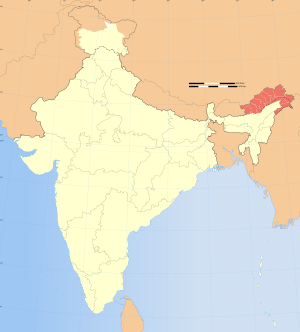1987 Sino-Indian skirmish
| 1987 Sino-Indian skirmish | |||||||
|---|---|---|---|---|---|---|---|
 The 1987 Sino-Indian skirmish occurred between China and India. |
|||||||
|
|||||||
| Belligerents | |||||||
|
|
|
||||||
| Commanders and leaders | |||||||
|
|
|
||||||
The 1987 Sino-Indian skirmish was the third military conflict between the Chinese People's Liberation Army Ground Force and Indian Army that occurred at Sumdorong Chu Valley, with the previous one taking place almost a quarter of a century earlier.
After her return to power in 1980 as Prime Minister of India, Indira Gandhi ordered a general review of India's security plans. In 1982-83, she approved a plan submitted by the Chief of the Army Staff, General K.V. Krishna Rao, to upgrade the sporadic deployment of forces along the Line of Actual Control with the People's Republic of China.
Since the late 1960s, India had developed an elaborate plan to defend the Himalayan frontier with China. This involved the provision of screening defences at the Line of Actual Control, or LAC, and the building of strong defence nodes at key points along the frontier. By the early 1980s, while the forces to man the defences were ready, the nodes were not, and the greatest weakness was in the fact that the servicing road network had not been built. The decision was taken to resume the defence infrastructure construction.
Since 1962, India had not returned to the site of its major defeat at Namka Chu, an east-west running stream which separates the Thag La and the Hathung La ridge to its south. India's efforts to occupy Thag La was the casus belli for the October 1962 Chinese military attack on India. Because there were no other feasible defensive locations north of Tawang, the government had more or less decided that in the event of a new war, they would abandon the town and prepare for battle at the Se La pass to its east. However, after the 1980 review, it was decided by the military strategists that it was important to defend Tawang in a future conflict. The army made it clear that the only viable line of defence for Tawang would be along the Hathung La ridge. In 1983, an Intelligence Bureau team went to the pasturage of Sumdorong Chu which is north-east of the confluence of the Namka Chu and Nyamjiang Chu. The defence forces stayed through the summer and returned in winter. This procedure was followed for two years. In 1986, Indian forces found that the Chinese had preceded them and set up semi-permanent structures there.
...
Wikipedia
